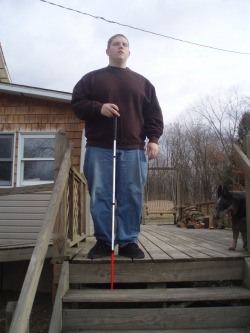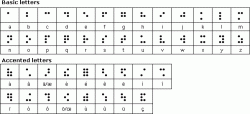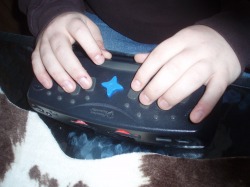Meet Christian

For me, blindness is not that big a deal. I was born blind and have many years of experience.
It all comes down to the approach one takes –like any limitation, you either overcome it or it overcomes you.
To compensate for my lack of vision, I use several adaptive devices that make life easier.
Braille computers only exist in fiction books. My computer is perfectly ordinary, with the exception of speech synthesis software, called JAWS. Basically, because I cannot see the screen, JAWS reads the screen to me.
This program allows me to use virtually every facet of computer programs the sighted use including, email, internet and documents.
My PC also has a program called Kurzweil 1000, which allows blind users to scan and read print text.
In addition to my PC, I also use a PAC Mate, a pocket PC specifically designed for, and used by blind people. Instead of a regular keyboard, the PAC Mate has nine keys, six representing each member of the Braille cell, the other three serving as enter, backspace and spacebar. It also has a cursor cross (arrow keys) and eight programmable function buttons, rather like an internet keyboard. It also uses JAWS software. There is a QWERTY version available, but I chose the Braille keyboard because I can type faster on it than a tiny QWERTY model.
I am currently attending Bloomsburg University, and I require very little adaptive assistance academically. I get my text books on CD and take tests using a reader/writer or by computer.
Another adaptive device I depend on and utilize on a regular basis is my cane. The cane, often called a white cane, lets me know what is in front of me from the waste down. From the waist up, I use what is known as facial vision- a form of echolocation that allows me to sense objects in the environment by hearing echoes from those objects.
Having learned to use a cane for independent travel from age 2, I have the ability to travel anywhere without sighted assistance.
People often try to help me and other blind individuals, assuming they don’t know where they are going or what they are doing. They don’t consider how they would feel if a stranger were to come up to them, grab them and drag them off in an unknown direction.
People often ask me when I will get a dog, or why I do not have one. I have chosen not to get a dog because I don’t deem it necessary. I already have a cane and that works for me.
People assume that when a blind person has a dog, the dog is leading the blind person. The dog is merely a cane with a brain; it serves the same function as a cane with the added benefit of providing advanced cues to the blind person that the cane may not pick up. If the dog thinks it’s safe to cross a street, it will tug on its harness. But it will not cross the street until the blind person has decided it is safe and commands the dog to move forward.
As for approaching someone with a dog, Grabbing a blind person’s guide dog is like jumping in someone’s car and grabbing their steering wheel. Petting guide dogs is also highly discouraged.
If you see a blind traveler, unless they ask for assistance, you can safely assume they are fine and know where they are going and what they are doing.
For personal items, like addresses and notes, I use a Braillewriter, which is similar to a typewriter, except instead of ink, the user creates readable tactile text. These functions can also be handwritten using a slate and stylus.
While some of my clothes are marked with Braille color labels, most can be recognized by touch and the color memorized. My parachute pants are green and the sweatshirt with the logo on the left front is tan for instance.
Otherwise, life is the same for blind people as it is for the sighted. Just like most people, I enjoy music, watching movies, our dogs, reading and writing and academics.
It all comes down to the approach one takes –like any limitation, you either overcome it or it overcomes you.
To compensate for my lack of vision, I use several adaptive devices that make life easier.
Braille computers only exist in fiction books. My computer is perfectly ordinary, with the exception of speech synthesis software, called JAWS. Basically, because I cannot see the screen, JAWS reads the screen to me.
This program allows me to use virtually every facet of computer programs the sighted use including, email, internet and documents.
My PC also has a program called Kurzweil 1000, which allows blind users to scan and read print text.
In addition to my PC, I also use a PAC Mate, a pocket PC specifically designed for, and used by blind people. Instead of a regular keyboard, the PAC Mate has nine keys, six representing each member of the Braille cell, the other three serving as enter, backspace and spacebar. It also has a cursor cross (arrow keys) and eight programmable function buttons, rather like an internet keyboard. It also uses JAWS software. There is a QWERTY version available, but I chose the Braille keyboard because I can type faster on it than a tiny QWERTY model.
I am currently attending Bloomsburg University, and I require very little adaptive assistance academically. I get my text books on CD and take tests using a reader/writer or by computer.
Another adaptive device I depend on and utilize on a regular basis is my cane. The cane, often called a white cane, lets me know what is in front of me from the waste down. From the waist up, I use what is known as facial vision- a form of echolocation that allows me to sense objects in the environment by hearing echoes from those objects.
Having learned to use a cane for independent travel from age 2, I have the ability to travel anywhere without sighted assistance.
People often try to help me and other blind individuals, assuming they don’t know where they are going or what they are doing. They don’t consider how they would feel if a stranger were to come up to them, grab them and drag them off in an unknown direction.
People often ask me when I will get a dog, or why I do not have one. I have chosen not to get a dog because I don’t deem it necessary. I already have a cane and that works for me.
People assume that when a blind person has a dog, the dog is leading the blind person. The dog is merely a cane with a brain; it serves the same function as a cane with the added benefit of providing advanced cues to the blind person that the cane may not pick up. If the dog thinks it’s safe to cross a street, it will tug on its harness. But it will not cross the street until the blind person has decided it is safe and commands the dog to move forward.
As for approaching someone with a dog, Grabbing a blind person’s guide dog is like jumping in someone’s car and grabbing their steering wheel. Petting guide dogs is also highly discouraged.
If you see a blind traveler, unless they ask for assistance, you can safely assume they are fine and know where they are going and what they are doing.
For personal items, like addresses and notes, I use a Braillewriter, which is similar to a typewriter, except instead of ink, the user creates readable tactile text. These functions can also be handwritten using a slate and stylus.
While some of my clothes are marked with Braille color labels, most can be recognized by touch and the color memorized. My parachute pants are green and the sweatshirt with the logo on the left front is tan for instance.
Otherwise, life is the same for blind people as it is for the sighted. Just like most people, I enjoy music, watching movies, our dogs, reading and writing and academics.
Braille

A Braille cell contains 2 columns with 3 dots each. The dots are numbered one through six. Most cells have several meanings depending on whether they stand-alone, appear at the beginning, in the middle, or at the end of a word.
Learn more about Braille here.
Learn more about Braille here.
PAC Mate

A PAC Mate, a pocket PC, is specifically designed for blind people. Instead of a regular keyboard, the PAC Mate has nine keys, six representing each member of the Braille cell, the other three serving as enter, backspace and spacebar. It also has speech synthesis software.
